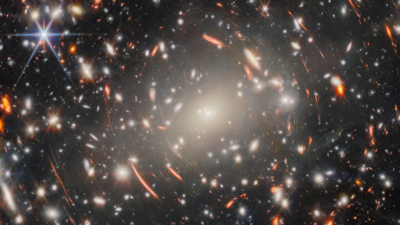
Galaxy cluster Abell S1063 (Nasa)
As part of the ‘picture of the month’ series, Nasa has revealed a new image taken by the
James Webb telescope
that gives a look into the distant past. This picture of the
galaxy cluster
Abell S1063 is a gigantic collection of galaxies lying 4.5 billion
light years
from Earth as part of the constellation Grus, also known as the Crane. The picture showcases galaxies surrounded by glowing streaks of light and warped arcs, which are of particular interest to scientists, as they represent faint galaxies from the distant past of this universe. Captured after 120 hours of observation, this image represents Webb's deepest look at a single celestial target.
This image is a
deep field image
, capable of capturing pictures of galaxies that have existed as early as 200 million years after the Big Bang. Deep field technology comprises of long exposure photography, focusing on a singular area in the sky, capable of collecting as much light as possible to draw out images of the most distant and faraway galaxies.
The Abell cluster was initially observed by the Nasa/ESA Hubble Telescope, a strong gravitational lens, with an aim to use the cluster’s image to study the
early Universe
. Upon studying, the image reveals a plethora of lensing arcs around the Abell S1063, providing a peek at previously unseen features and a multitude of faint galaxies. This observation is part of the GLIMPSE programme, which has a mission to study a period called the ‘
Cosmic Dawn
’ when the universe was only a few million years old. Studying images captured through
gravitational lensing
has the power to enrich our understanding of the universe and the emergence of the very first galaxies.

 1 day ago
40
1 day ago
40




























 English (US)
English (US)